Epaulette

Epaulette (/ˈɛpəlɛt/; also spelled epaulet)[1] is a type of ornamental shoulder piece or decoration used as insignia of rank by armed forces and other organizations. In several European armies epaulettes are also worn by all ranks of elite or ceremonial units when on parade.
Epaulettes are fastened to the shoulder by a shoulder strap or "passant", a small strap parallel to the shoulder seam, and the button near the collar, or by laces on the underside of the epaulette passing through holes in the shoulder of the coat. Colloquially, any shoulder straps with marks are also called epaulettes. The placement of the epaulette, its color and the length and diameter of its bullion fringe are used to signify the wearer's rank. At the join of the fringe and the shoulderpiece is often a metal piece in the form of a crescent. Although originally worn in the field, epaulettes are now normally limited to dress or ceremonial military uniforms.
Etymology
Epaulette is a French word meaning "little shoulder" (diminutive from épaule, meaning "shoulder").
History

Epaulettes bear some resemblance to the shoulder pteruges of ancient Roman military costumes. However their direct origin lies in the bunches of ribbons worn on the shoulders of military coats at the end of the 17th century, which were partially decorative and partially intended to prevent shoulder belts from slipping. These ribbons were tied into a knot which left the fringed end free. This established the basic design of the epaulette as it evolved through the 18th and 19th centuries.[2]
From the 18th century on, epaulettes were used in the French and other armies to indicate rank. The rank of an officer could be determined by whether an epaulette was worn on the left shoulder, the right shoulder or on both. Later a "counter-epaulette" (with no fringe) was worn on the opposite shoulder of those who wore only a single epaulette. Epaulettes were made in silver or gold for officers, and in cloth of various colors for the enlisted men of various arms. By the early eighteenth century, epaulettes became the distinguishing feature of an officer, leading to officers of military units without epaulettes to petition their government for the right to wear epaulettes, to ensure that they would be recognized as officers.[3] Certain cavalry specialties wore flexible metal epaulettes referred to as shoulder scales, rarely worn on the field. During the Napoleonic Wars and subsequently through the 19th century, grenadiers, light infantry, voltigeurs and other specialist categories of infantry in many European armies wore cloth epaulettes with wool fringes in various colours to distinguish them from ordinary line infantry. "Flying artillery" wore "wings", similar to an epaulette but with only a bit of fringe on the outside, which matched the shoulder seam. Heavy artillery wore small balls representing ammunition on their shoulders.
Today, epaulettes have mostly been replaced by a five-sided flap of cloth called a shoulder strap, which is sewn into the shoulder seam and the end buttoned like an epaulette.
An intermediate form in some services, such as the Russian Army, is the shoulder board, which neither has a fringe nor extends beyond the shoulder seam. This originated during the nineteenth century as a simplified version for service wear of the heavy and conspicuous full dress epaulette with bullion fringes.
From the shoulder board was developed the shoulder mark, a flat cloth tube that is worn over the shoulder strap and carries embroidered or pinned-on rank insignia. The advantages of this are the ability to easily change the insignia as occasions warrant.
Airline pilot uniform shirts generally include cloth flattened tubular epaulettes having cloth or bullion braid stripes, attached by shoulder straps integral to the shirts. The rank of the wearer is designated by the number of stripes: Four for captain, three for first officer (copilot), two for Second Officer (flight engineer). Airline captains' uniform caps usually will have a braid pattern on the bill.
In literature, film and political satire, dictators, particularly of unstable Third World nations, are often depicted in military dress with oversized gold epaulettes.
Canada
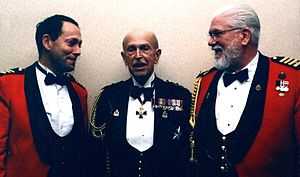
In Canada, epaulette or epaulet is used to describe the shoulder strap of a military or police shirt, jacket or tunic and is used informally as a synonym for slip-on, a flat cloth sleeve (called in the US, a shoulder mark) worn ("slipped on") on the shoulder strap.
After Unification and prior to the issue of the Distinct Environmental Uniform, musicians of the Band Branch wore epaulettes of braided gold cord on the CF uniform.
Epaulettes are still worn on some Army Full Dress, Patrol Dress, and Mess Dress uniforms. Epaulettes in the form of shoulder boards are worn with the officer's white Naval Service Dress.
France
Until 1914 officers of most French Army infantry regiments wore gold epaulettes in full dress, while those of mounted units wore silver. No insignia was worn on the epaulette itself, though the bullion fringe falling from the crescent differed according to rank.[4] Other ranks of most branches of the infantry, as well as cuirassiers wore detachable epaulettes of various colours (red for line infantry, green for Chasseurs, yellow for Colonial Infantry etc.) with woollen fringes, of a traditional pattern that dated back to the 18th Century. Other cavalry such as hussars, dragoons and chasseurs à cheval wore special epaulettes of a style originally intended to deflect sword blows from the shoulder.
In the modern French Army, epaulettes are still worn by those units retaining XIXth century-style full dress uniforms, notably the ESM Saint-Cyr and the Garde Républicaine. The French Foreign Legion continued to wear their green and red epaulettes, except for a break from 1915 to 1930. In recent years the Marine Infantry and some other units have readopted their traditional fringed epaulettes in various colours for ceremonial parades. The Marine nationale and the Armée de l'Air do not use epaulettes, but non-commissioned and commissioned officers wear a gilded shoulder strap called attente, which original function was to clip the epaulette onto the shoulder. The attentes are also worn by Army generals on dress uniform.
-

Cadets of the ESM Saint-Cyr in full uniform. The gold epaulettes shown are those of cadet officers, while those of ordinary cadets are red.
-

Yellow epaulettes of the French Marines
-

Red and green epaulette of the French Foreign Legion
-

Air Force General Abrial in dress uniform. Notice the attentes.
-
.jpg)
Army General de Villiers in dress uniform. Notice the attentes.
-
.jpg)
Admiral Guillaud in dress uniform. Notice the attentes.
-

Gendarmerie nationale cadet in full uniform. Notice the attente keeping the epaulette onto the shoulder.
Germany
German Army uniforms were formerly known for a four cord braided "figure-of-eight" decoration which acted as a shoulder board for senior and general officers. This is called a shoulder knot. Although it was once seen on US Army uniforms, it remains only in the mess uniform. This type is still used in Venezuela, Chile, Colombia, Ecuador and Bolivia.
Haiti
Gold epaulettes in Haiti, were frequently worn throughout the 18-19th centuries in full dress.[5] During the Haitian Revolution, Gen. Charles Leclerc of the French Army wrote a letter to Napoleon Bonaparte saying, "We must destroy half of those in the plains and must not leave a single colored person in the colony who has worn an epaulette.”[6][7]
-

Haitian revolutionary leader Toussaint Louverture, wears a four-starred general-in-chief's uniform with epaulettes.
-
_Portrait.jpg)
Jean-Pierre Boyer, former battalion commander of the French Revolutionary Army, later became President of Haiti controlling the entire island of Hispaniola for twenty-two years.
Sweden
Epaulettes first appeared on Swedish uniforms in the second half of the 18th century. The epaulette was officially incorporated into Swedish uniform regulations in 1792, although foreign recruited regiments had had them earlier. Senior officers were to wear golden crowns to distinguish their rank from lower ranking officers who wore golden stars.
Epaulettes were discontinued on the field uniform in the mid 19th century, switching to rank insignia on the collar of the uniform jacket. Epaulettes were discontinued when they were removed from the general issue dress uniform in the 1930s. They are however still worn by the Royal Lifeguards and by military bands when in ceremonial full dress.
-

Royal Lifeguards Officer in ceremonial full dress at the Royal Palace in Stockholm
-

Swedish king Oscar II wearing an admiral's uniform, as shown by the three stars on his epaulettes
United Kingdom
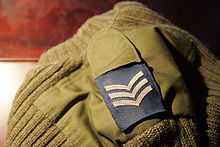
Epaulettes first appeared on British uniforms in the second half of the 18th century. The epaulette was officially incorporated into Royal Navy uniform regulations in 1795, although some officers wore them before this date. Under this system Flag Officers wore silver stars on their epaulettes to distinguish their ranks. A Captain with at least three years seniority had two plain epaulettes, while a Junior Captain wore one on the right shoulder, and a Commander one on the left.[8]
Before World War I the British Army stopped wearing epaulettes in the field, switching to rank insignia embroidered on the cuffs of the uniform jacket. This was found to make officers a target for snipers, so the insignia was moved to the shoulder straps, where it was less conspicuous.
British cavalry on active service in the Sudan (1898) and during the Boer War (1899–1902) sometimes wore epaulettes made of chainmail to protect against sword blows landing on the shoulder. The blue "Number 1 dress" uniforms of some British cavalry regiments and yeomanry units still retain this feature in ornamental silvered form.[9]
The current multi terrain pattern (MTP) and the older combat uniform (DPM) has the insignia formerly used on shoulder straps displayed on a single strap worn vertically in the centre of the chest.
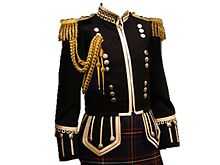
Police shoulder strap colours
When policing large events, some specialist police officers' shoulder straps are colour-coded according to their role:
- Bronze Commander - Yellow
- Silver Commander - Grey
- PSU Commander - Red
- PSU Sergeants - White
- Medics - Green
- Tactical Advisors - Royal Blue
- Evidence Gatherers - Orange[10]
United States
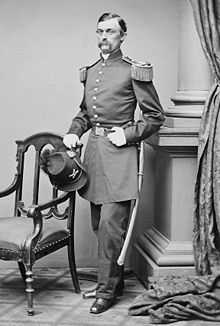
Epaulettes were authorized for the United States Navy in the first official uniform regulations, Uniform of the Navy of the United States, 1797. Captains wore an epaulette on each shoulder, lieutenants wore only one, on the right shoulder.[11][12] By 1802, lieutenants wore their epaulette on the left shoulder, with lieutenants in command of a vessel wearing them on the right shoulder;[13] after the creation of the rank of master commandants, they wore their epaulettes on the right shoulder similar to lieutenants in command.[14] By 1842, captains wore epaulettes on each shoulder with a star on the straps, master commandant were renamed commander in 1838 and wore the same epaulettes as captains except the straps were plain, and lieutenants wore a single epaulette similar to those of the commander, on the left shoulder.[15] After 1852, captains, commanders, lieutenants, pursers, surgeons, passed assistant and assistant surgeons, masters in the line of promotion and chief engineers wore epaulettes.[16]
Epaulettes were specified for all United States Army officers in 1832; infantry officers wore silver epaulettes, while those of the artillery and other branches wore gold epaulettes, following the French manner. The rank insignia was of a contrasting metal, silver on gold and vice versa.
In 1851 the epaulettes became universally gold. Both majors and second lieutenants had no specific insignia. A major would have been recognizable as he would have worn the more elaborate epaulette fringes of a senior field officer. The rank insignia was silver for senior officers and gold for the bars of captains and first lieutenants. The reason for the choice of silver eagles over gold ones is thought to be one of economy; there were more cavalry and artillery colonels than infantry so it was cheaper to replace the numerically fewer gold ones.
Shoulder straps were adopted to replace epaulettes for field duty in 1836.
Licensed officers of the U.S. Merchant Marine may wear shoulder marks and sleeve stripes appropriate to their rank and branch of service. Deck officers wear a foul anchor above the stripes on their epaulettes and engineering officers wear a three-bladed propeller. In the U.S. Merchant Marine the correct wear of epaulettes depicting the fouled anchor is with the un-fouled stock of the anchor forward on the wearer.
Gallery
-
Carl von Clausewitz, Prussian general
-
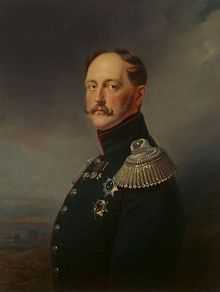
Emperor Nicholas I of Russia
-
Royal Guardsman in Oslo, Norway
-

Otto von Bismarck wearing epaulettes
-

Simón Bolívar, Venezuelan military leader
-

Portrait of a Russian General with epaulettes
See also
- Shoulder loops in the uniform of the Boy Scouts of America
- Spaulder
References
- ↑ http://www.merriam-webster.com/dictionary/epaulet
- ↑ John Mollo, page 49 "Military Fashion", ISBN 0-214-65349-8
- ↑ Wilkinson-Latham, R: The Royal Navy 1790–1970, page 5. Osprey Publishing, 1977
- ↑ André Jouineau, Officers and Soldiers of the French Army 1914, ISBN 978-2-352-50104-6
- ↑ "Education, Volume 23". New England Publishing Company. 1903. p. 281. Retrieved 4 January 2015.
- ↑ "General Leclerc in Saint-Domingue 1801–1802". Brown University. Retrieved 4 January 2015.
- ↑ Dayan, Joan. "Haiti, History, and the Gods". p. XVI. Retrieved 4 January 2015.
- ↑ Epaulettes at the National Maritime Museum website
- ↑ R.M. Barnes page 316 "Military Uniforms of Britain and the Empire", Sphere Books 1972
- ↑ "Public order procedure". North Yorkshire Police. Retrieved 3 February 2012.
- ↑ Rankin, Col. Robert H.: "Uniforms of the Sea Services", 1962
- ↑ "Uniform Regulations, 1797". Retrieved 2009-10-22.
- ↑ "Uniform Regulations, 1802". Retrieved 2009-10-22.
- ↑ "Uniform Regulations, 1814". Retrieved 2009-10-22.
- ↑ "Uniform Regulations, 1842". Retrieved 2009-10-22.
- ↑ "Uniform Regulations, 1852". Retrieved 2009-10-22.
External links
Various 18th and 19th Century Epaulets (bottom of page) http://www.militaryheritage.com/pastprojects.htm
| Look up epaulettes in Wiktionary, the free dictionary. |
| Wikimedia Commons has media related to Epaulettes. |



